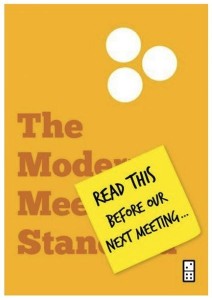
5 Tips for Making Meetings Actually Work
Stop and think about how much of your time is spent in meeting in an average week at your church. Now, do some quick math to calculate that across your team. Wowsers! That’s a lot of time! (Bonus: Assign some monetary value to each of those hours.)
Clearly, you need to work on ensuring that your team is being a good steward of all that meeting time.
Although it can seem like a “plumbing” issue of how the church does its work, in many ways the meeting culture of your church could be a make-or-break aspect of what is either pushing your ministry forward or holding it back. As I’ve had the honor of being in the orbits of some fantastic churches over the years, I’ve noticed some healthy habits that those leadership teams live by to get the most out of their meetings. Rather than seeing meetings as a necessary evil of “doing church”, these teams are looking for ways to optimize their meeting culture towards performance that pushes them forward. Here are some healthy habits I’ve seen in churches that are making a difference today:
Use meetings to make decisions, not to disseminate information.
Meetings are disagreements to move the organization forward. Healthy teams use meetings as a place to come together to make decisions. More pointedly, leaders use meetings to make decisions. A good meeting should be built around ideas that need to be debated and discussed in the context of an impending decision. Meetings are not a place to simply pass out information or keep everyone informed. It’s a waste of your team’s time to use meetings as a place to ensure they are up to speed on what’s happening at the church.
Adults are basically “just in time” learners, so when you use a meeting to simply pass along information, they are almost hardwired to not pay attention because they can’t put the information into practice right away. However, you can turn this same dynamic on its head by using meetings to present a desired and debatable outcome that you’re going to discuss. People can’t help but lean in and want to participate when change is on the horizon based on this meeting. When there are consequences to meetings, people show up and are ready to jump in. If the meeting feels inconsequential, your team will disengage at best or maybe even resent the meeting.
3 Other Ways to Disseminate Information to Your Team Besides Calling a Meeting
- Voice Messages // You’d be amazed how much information you can pass in a 5 minute audio message recorded on your phone. It’s easy to record your voice and email it out to your team.
- “What to Expect” Documents // In just one page, you can outline a lot of information that people need to know about an upcoming event or activity at the church.
- Weekly Check in Email // Many churches have a standard report email that is generated every week with data that the entire team needs to know. Get your information to hijack on the back of that communication.
Ensure people come prepared to discuss.
No agenda? No meeting! If whoever is calling the meeting doesn’t have time to prepare the people attending the meeting for what is being discussed, it’s probably best not to meet. People don’t like surprises and it’s a bad use of people’s time to get their gut reaction to issues without them having time to prepare. If the decisions being made in the meeting are of such low consequence that people don’t need to think about them ahead of time, then they should be delegated to a team member to make the decision and inform the team later. The prep is both an agenda that outlines the decisions that will be made at the meeting and reading materials to help people as they process the decision.
5 Elements of a Compelling Agenda
- Decision: // What is the big decision that is being made at this meeting? This is the overall driver for why you are calling people together.
- Attendees // A clear list of who will be at the meeting. If people don’t know each other, a one-line bio is helpful.
- Please Read // A list of resources designed to bring the team up to speed on the issue at hand.
- What’s at Stake // Why is this such an important decision? A clear and compelling reason why this decision needs to be made at this time.
- Rules of Engagement // Some ground rules about how the team is going to go about “doing” the meeting.
Healthy teams work to avoid the feedback bubble.
Learning teams win. Churches that are making a difference in their communities are led by teams of people that are looking for ways to learn from other organizations and apply those lessons to their church. Stagnant churches keep to their own small tribe and shout into the echo chamber of their community. Healthy meetings seek to bring in data from a wide variety of sources to push to a better answer, not the answer that was assumed from the outset. Too many churches just run the same plays over and over and aren’t committed to bringing in outside voices to help them make better decisions. If you are looking for a way to improve your decision-making as a team, you need to bring in voices from other circles to help you make better decisions.
This is particularly important when we think about our ultimate mission as a church. Every church needs to find ways to leverage opportunities to reach people beyond their own church. In fact, the local church is the only organization in the world that exists not for its member but for people not yet connected to the church! As Colossians 4:5 says, “Be wise in the way you act toward outsiders; make the most of every opportunity.” The hard truth is the voice of the “insider” will always be louder than the “outsider” and so your church needs to find ways to include those voices at your decision-making table. If you only listen to those people who are already with your church, you will miss the opportunity to reach people who haven’t been reached yet!
3 Ways to Add Outside Voices to Your Decision-Making Process
- Data is Your Friend // Find hard numbers that talk about what is actually happening rather than just your opinion or hunches. There is no bad information, just information you don’t like.
- Invite People In // Who is attending the meetings at your church should be driven by the decisions being made, not by tradition or hierarchy. Pull in people who can speak first-hand about the decisions being made.
- Coaches // Growing churches bring in people who have been down the road they are looking at before. A day with a coach or consultant can help bring added clarity to the decisions you make as a team.
Capture action steps and assign responsibilities.
Take massive action. The reason you’ve called meetings at your church is to make decisions. Therefore, coming out of the meeting should be a series of decisions that need to be assigned to team members to follow up on. In fact, the very essence of what “happens” coming out of meetings is new and vibrant energy that has been released. If your meetings aren’t leading to people taking action, then you are just using your meetings to inform people of decisions that have already been made and you should stop meeting.
3 Vital Pieces Needed to Record Next Steps After a Meeting
- Owner // Who is the person responsible for the next step coming out of the meeting?
- Outcome // What was the decision that was made by the team?
- Due Date // When does the owner need to make sure the item is completed by?
As important as the agenda is the pre-reading material, someone from the meeting needs to follow up quickly with “action steps” that are going to be initiated because of the meeting. Ideally, those are recorded in the meeting and sent right away. Again, the meeting should be a tool to push the church forward, so now that decision has been made, the organization should move to take action on that decision!
Meetings should be an exciting event, not a total bore.
All meetings should be optional and exciting. If you are just getting together for the sake of getting together, stop it. Don’t force your people to sit through another meeting just for the sake of meeting. Cut your “repeating” meetings out or at least in half. As a team leader, you need to ensure that each meeting is exciting and engaging, not boring. If the meeting is putting people to sleep, then the team leader isn’t doing their job.
6 Ways to Make Your Church Team Meetings More Exciting
- Make Them Optional … really! // If people can choose not to come to the meeting and won’t suffer any retribution from the team leader, you’d be amazed how creative the team leader will get to make the meeting great.
- Add Food // Something almost magical happens when you add food to a meeting. Have a favorite exotic food? Add it to the start of your next regular meeting and see what happens. (Skip the donuts … it’s been overdone.)
- Standing Meeting // Okay … this might not be fun, but it is just effective. Take all the chairs out of the room that you meet in and have the meeting standing up. You’ll be amazed at how quickly you move through the agenda!
- Thank You Notes // Kick off your meeting with some gratitude! Hand out thank you cards to everyone on your team and have them share something that someone else on another team at the church did that was fantastic. After people share, have them write thank you notes to the people that they shared about!
- Get Rid of the Table // The physical space you meet in matters. Get rid of that big table that blocks everyone. Paint the walls a bright color. Making a physical change can switch people’s attitudes about your meetings. What if you themed the room something fun? Hawaiian Luau Theme? Christmas in July?
- Stick It Up! // In preparation for the meeting, put 3-4 pieces of poster board around the room with short sentences describing issues your church is facing. As people arrive for the meeting, give them a pile of post-it notes and a marker and ask them to jot down solutions for each issue and stick it up on the boards around the room. Take some time to discuss the ideas generated.
It is important to connect with your team relationally, but don’t do that poorly through something masquerading a meeting. Cut out some meetings and then use that freed up time to go do something fun with your team and actually connect!
Interest in learning more about meetings? Listen to Al.
If you are interested in diving deeper in great meeting culture, you need to follow Al Pittampalli and Modern Meeting Standard. He is a leader in thinking about how organizations do meetings well and is leading a revolution to get all kinds of organizations to improve them! Much of my thought has been shaped by Al on this front and I find myself coming back to him time and again when I’m faced with needing to retool our meeting culture one more time! I’m grateful for his leadership.

Tags: Meetings, Rich Birch, Staff Meetings, leading meetings

















